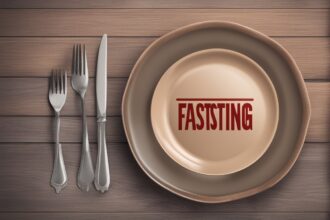Intermittent fasting (IF) has surged in popularity as a lifestyle choice for weight loss, improved metabolic health, and overall wellness. However, with its rise, numerous myths and misconceptions have emerged, often deterring people from trying it or causing unnecessary confusion. In this post, we’ll be debunking common intermittent fasting misconceptions to help you separate fact from fiction and make informed decisions about whether this eating pattern is right for you.
What Is Intermittent Fasting, Really?
Before diving into the myths, let’s clarify what intermittent fasting entails. IF is not a diet but a pattern of eating that alternates between periods of fasting and eating. Popular methods include the 16/8 method (fasting for 16 hours, eating during an 8-hour window), the 5:2 diet (eating normally for five days and restricting calories on two days), and alternate-day fasting. Despite its simplicity, misunderstandings about IF abound. By debunking common intermittent fasting misconceptions, we aim to provide clarity on what this practice truly involves and how it can be adapted to various lifestyles.
Myth 1: Intermittent Fasting Means Starving Yourself
One of the most pervasive myths is that intermittent fasting equates to starvation. This couldn’t be further from the truth. Fasting in IF is about timing your meals, not eliminating food altogether. During eating windows, you’re encouraged to consume nutrient-dense foods to meet your caloric and nutritional needs. The goal isn’t deprivation but rather allowing your body periods of rest from digestion to promote metabolic benefits. Debunking common intermittent fasting misconceptions like this one helps potential fasters understand that IF is a sustainable approach, not a punishment.
For more on how to structure your meals during IF, check out our guide on Intermittent Fasting Meal Planning.
Myth 2: Intermittent Fasting Slows Down Your Metabolism
Another widespread belief is that fasting slows your metabolism, making weight loss harder. In reality, short-term fasting can actually boost metabolic rate by increasing levels of norepinephrine, a hormone that enhances fat burning. Studies have shown that intermittent fasting does not negatively impact metabolism when done correctly and paired with adequate nutrition. Debunking common intermittent fasting misconceptions around metabolism is crucial, as this myth often discourages people from even starting IF. Remember, the key is to avoid extreme calorie deficits over prolonged periods, which can indeed affect metabolic health.
Myth 3: You Can Eat Anything During Eating Windows
While IF focuses on when you eat rather than what you eat, the idea that you can indulge in junk food without consequences is misleading. Quality matters. Consuming processed, high-sugar, or unhealthy foods during your eating window can negate the potential benefits of fasting, such as improved insulin sensitivity and weight management. Debunking common intermittent fasting misconceptions about food choices emphasizes the importance of balanced nutrition. Pairing IF with whole, nutrient-rich foods maximizes its effectiveness. For tips on healthy eating during IF, explore our post on Healthy Eating During Fasting Windows.
Myth 4: Intermittent Fasting Causes Muscle Loss
Many worry that fasting leads to muscle loss, especially among fitness enthusiasts. However, research indicates that intermittent fasting, when combined with resistance training and adequate protein intake, does not cause significant muscle loss. In fact, fasting may promote the production of human growth hormone (HGH), which supports muscle preservation and fat loss. Debunking common intermittent fasting misconceptions about muscle loss reassures active individuals that IF can align with fitness goals. If you’re concerned about maintaining muscle mass, read our article on Fasting and Fitness Tips.
Myth 5: Intermittent Fasting Isn’t Safe for Everyone
While it’s true that IF may not be suitable for certain groups—such as pregnant or breastfeeding women, individuals with specific medical conditions, or those with a history of eating disorders—it is generally safe for most healthy adults. The key is to approach fasting with mindfulness and, if necessary, under medical supervision. Debunking common intermittent fasting misconceptions about safety highlights that IF can be adapted to individual needs with proper guidance. Always consult a healthcare provider if you’re unsure whether IF is right for you. For more on who should avoid fasting, see our detailed guide on Who Should Avoid Intermittent Fasting.
Why Debunking These Myths Matters
Misinformation about intermittent fasting can create unnecessary fear or unrealistic expectations, preventing people from experiencing its potential benefits. By debunking common intermittent fasting misconceptions, we empower individuals to make informed choices based on science and practical advice. Whether you’re a beginner or a seasoned faster, understanding the truth about IF can help you tailor the practice to your lifestyle. Curious about the science behind fasting? Dive into our post on The Science Behind Intermittent Fasting.
Disclaimer: The information provided in this article is for educational purposes only and should not be considered medical advice. Intermittent fasting may not be suitable for everyone, and results can vary based on individual health conditions and lifestyles. Always consult with a healthcare professional or registered dietitian before starting any new dietary or fasting regimen, especially if you have pre-existing medical conditions or concerns.
References
- Harvard Health Publishing – Intermittent Fasting: Surprising Update
- National Center for Biotechnology Information – Effects of Intermittent Fasting on Health, Aging, and Disease
- Mayo Clinic – Intermittent Fasting: What Is It, and How Does It Work?
- New England Journal of Medicine – Effects of Intermittent Fasting on Health and Aging
- WebMD – Intermittent Fasting: What You Need to Know
This content is for informational purposes only and not a substitute for professional advice.






